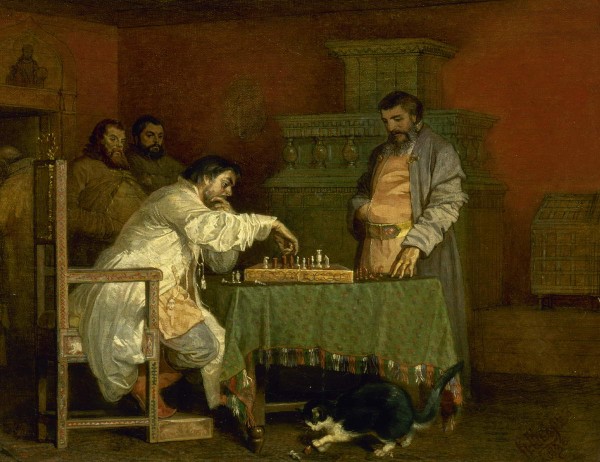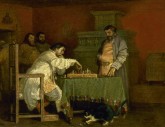Schwartz Vyacheslav. Scene from the Domestic Life of Russian Tsars (Playing Chess)
1865
- oil on картон, наклеенный на холст. 26,5 х 33
- Ж-1444
Пост.: 1907 от Г.З. Агафонова (С.-Петербург)
- Period Late 19th century
- CategoryHistory Painting, Genre Painting
- Share
An art, a science, a sport, a model for solving mathematical and psychological problems - all of this can be applied to chess, one of the world's most popular games. Its history dates back to chaturanga, a sixth century Indian battle game involving the simultaneous participation of four armies.
Chess entered Russia directly from the East. The Russian language therefore preserves the original names of the pieces, such as the Persian word firzan (counsellor), which in Europe gradually evolved into the queen. Chess is first mentioned in Russian written sources in the thirteenth century, although archaeological excavations testify that chess was played even earlier, as far back as the eleventh century. Russian bogatyrs - the heroes of Russian traditional heroic poems (bylini) - played "overseas chess". In the fifteenth century, chess became popular among all classes of Russian society, even in the face of a church ban. The church condemned the game along with the playing of musical instruments, dice games and drunkenness.
Chess was also censured in Ivan the Terrible's Rules for Russian Households (Domostroi) and forbidden by his Hundred Chapters (Stoglav). The Russian historian Zabelin affirms that it was nevertheless one of the favourite pastimes of the Russian sovereigns in the pre Petrine period. If one is to believe the English ambassador, Horsey, the finale to Alexei Tolstoy's tragedy The Death of Ivan the Terrible, in which the Tsar dies while playing chess, is based on an historical fact.
The Russian boyars were excellent chess players and their command of the game was noted by foreigners. Exquisite chess sets are listed in the inventories of the Moscow Armoury alongside precious goblets and chalices. The position of "chess man" was created in order to inspect the manufacturing process and the condition of made sets. Play and Passion in Russian Fine Art. St-Petersburg. 1999. P. 252.
Schwarz aims at the psycho logically authentic portrayal of man and the historically concrete description of an era. The interior in the painting is typical for the mid-seventeenth century. The detailed depiction of the contents of the room make one want to study the picture for a long time. The cat playing with the ball imparts the charm of domestic comfort. Play and Passion in Russian Fine Art. St-Petersburg. 1999. P. 253.
Vyacheslav Schwartz, who was the first person in Russian art to paint genre scenes with a historical setting, depicts Alexis Mikhailovich playing chess with one of his boyars. This was a favourite entertainment for the Tsar when he was with a group of close associates with whom he liked to shut himself away in the evening. The game was so popular at court that there were special craftsmen serving in the Armoury Palace whose job was to make and repair chess pieces.

